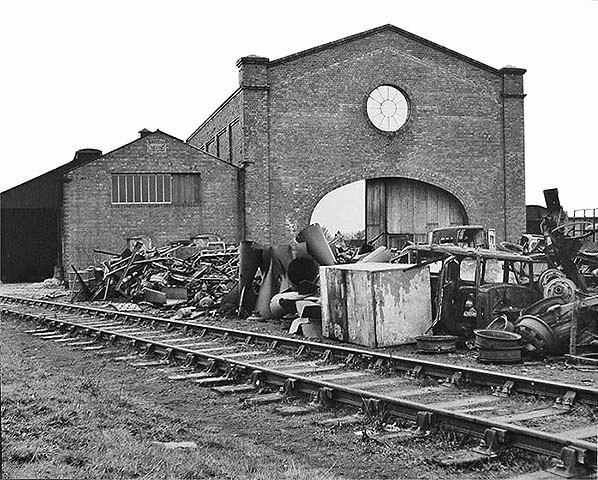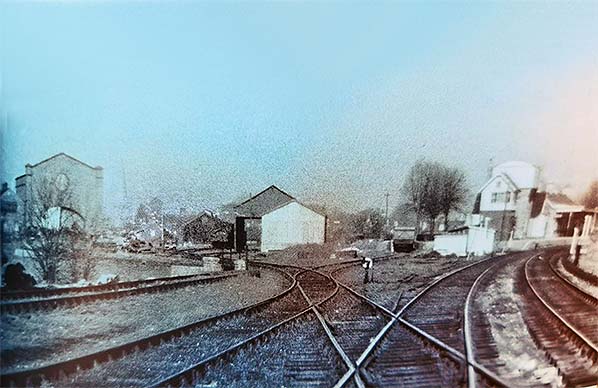
Station Name:CIRENCESTER WATERMOORCirencester Watermoor Gallery 3: c1960 - 10 September 1961
watermoor_old35..jpg)
Ex-SR U Class 2-6-0 No. 31629 arrives with a southbound train, the first vehicle of which hints of being of LNER origin. The date is unrecorded but the flag on the left suggests the Up line was out of use, suggesting March 1960 or very soon afterwards. This locomotive was shedded at Eastleigh at this time. The water tower displays its larger tank installed in 1912. The stepped upper part of the supporting structure was also a later addition, perhaps as much for aesthetic reasons as to provide additional support. Despite closure being not too far in the future and the Up platform presumably out of use, the station still manages to present a quite neat and tidy scene. It would appear the platform in front of the Down side waiting shelter, out of view to the right, had been resurfaced at some point in time. This sort of what might be called 'minimal improvement' was not uncommon.
Photo from Jim Lake collection old15.jpg)
By early 1960 the up line had been lifted and sleepers are awaiting removal.
Photo
from John Mann collection
old16.jpg) An unidentified ex-SR Maunsell U class 2-6-0 pauses on its way south sometime after March 1960. The first vehicle is to a GWR Hawksworth design. The photograph is undated but with the Up line being lifted it will be within the final year of the line's passenger service. Wartime tank traps stand on the right. The barrow crossing connected the two platforms and although it may be an illusion it appears a path led to the houses on the right. If so, perhaps the houses were occupied by railway staff.
Photo from John Mann collection old17.jpg)
Sometime after March 1960 an unidentified ex-SR Maunsell U class 2-6-0 arrives on its way south with business apparently hardly brisk. With the Up line being lifted and clutter congregating on the Up platform the scene presented is a rather desolate one. The curve through the station began a few yards south of the platforms and continued almost right through the town until turning northwards again at Lower Norcote. Also evident in this view is the position of the station on embankment. By this time all trains obviously used the Down platform upon which a good sized shelter was provided if little else.
Photo from John Mann collection old18.jpg)
By late 1960 the up line sleepers had been lifted. One of the station’s two water cranes is seen at the south end of the down platform.
Photo from John Mann collection  After closure of the line to all traffic in 1964, a scrap yard occupied the entire station site until the land was required for road development. This picture shows the GWR works which closed after the Grouping in 1923. The date of this picture is unknown but as track is still in place it will be before the goods yard closed. The scrap yard has already occupied the site of the GWR works. After closure of the line to all traffic in 1964, a scrap yard occupied the entire station site until the land was required for road development. This picture shows the GWR works which closed after the Grouping in 1923. The date of this picture is unknown but as track is still in place it will be before the goods yard closed. The scrap yard has already occupied the site of the GWR works.Photo from Paul Strong collection old19.jpg) Cirencester Watermoor station looking north circa late 1960. The barrow crossing in the foreground was used by passengers going to and from the down platform. Watermoor signal box has been demolished. The box was abolished when the Up road through the station was taken out of use in March 1960 and demolished soon afterwards. With abolition of the box, Watermoor goods yard was controlled by a ground frame via a key attached to the South Cerney - Foss Cross train staff
Photo from John Mann collection old20.jpg)
With the Up line lifted and a number of suspected enthusiasts leaning out of the train this photo was taken in August 1961 in the final weeks before withdrawal of passenger services. In addition, locomotive No. 31413 was shedded at Eastleigh from 26 May 1961. It is minus a shedplate, suggesting transfer had only recently occurred. The locomotive is an ex-SR Maunsell N class 2-6-0, a class which had its origin with the South Eastern & Chatham Railway. The class earned the nickname "Woolworths" due to a number being built from kits of parts supplied by Woolwich Arsenal, while on the South Eastern section the peculiar nickname "Mongolipers" was applied. No. 31413 was the penultimate class member to be built, at Ashford in 1934. She was to survive in traffic until June 1964. Fuller histories of this interesting class may be found online. Back at Watermoor, on the right stands a once-familiar brazier used to prevent water cranes from freezing during winter. The wheel to operate the water valve appears to be missing, which might suggest the water crane was out of use by this time. The houses on the right stood on the north side of Bridge Road, south of what is now Kingsmead. It is near this point that a section of former railway embankment survives, where the bridge over what was Gas Lane once stood.
Copyright photo from ColourRail old21.jpg)
On Sunday 10 September 1961 the RCTS ran their 'Farewell to the M&SWJR' railtour, see here at Watermoor following a disgorge of passengers of whom some appear more interested in the weeds than anything else. The train ran from Swindon to Cheltenham Spa St James and returned to Swindon via Kemble. By now single track through Cirencester, the line officially closed to passengers the following day. On the same day, 10 September 1961, a second railtour visited the line. This was a Stephenson Locomotive Society tour, apparently from and to Birmingham Snow Hill using ex-GWR No. 7808 'Cookham Manor'. Seen here with the RCTS railtour is ex-GWR Churchward 43xx class 2-6-0 No. 5306. The rather diminutive RCTS headboard is barely visible at the top of the smokebox. While the locomotive's shedplate is unreadable, records show No. 5306 to have been allocated to Pontypool Road shed at this time so quite why she appeared on this railtour is open to question.
Copyright photo from ColourRail old22.jpg)
The Stephenson Locomotive Society railtour of 10 September 1961 pauses at Watermoor with No. 7808 'Cookham Manor'. Regular passenger services had ceased the previous day and excepting the track lifting operation this was to be final train over the section north of Cirencester. On the left the running-in board has already been removed while that on the Up platform still stands, right background. The people on the platforms are thought to have comprised mainly local people there to witness the event, although some will be passengers who have alighted to take photographs. For how long the train paused was not recorded.
Photo by David Hopkins watermoor_old32.jpg)
On 10 September 1961 two railtours visited the M&SWJR to mark the withdrawal of passenger services over the line. The first tour, using locomotive No. 5306, is depicted and described elsewhere. This scene depicts the second tour headed by No. 7808 'Cookham Manor'. The train formation was seven BR Mk 1 vehicles and ran with the reporting number 1X06 as seen here. Run by the Stephenson Locomotive Society this train, unlike the other tour of the same day, traversed the M&SWJR line in both directions. While some details of the tour remain a little hazy, the route was Birmingham Snow Hill, Stratford-upon-Avon, Broadway, Cheltenham Spa Malvern Road and thence to Andover Junction. There was then a run from Andover Junction to Ludgershall, returning to Swindon Works Siding. This was apparently to allow an optional, albeit brief, visit to Swindon Works. The return to Birmingham Snow Hill from Swindon was via the same route as the outward journey. In this scene, reputedly at Cirencester, the precise location is difficult to determine but thought to be just south of the station during the return journey. Precisely what is attracting the attention of the youngsters in the foreground is not known. Locomotive No. 7808 is a member of the 7800 or 'Manor' class 4-6-0s. She remained in service until December 1965 and went on to be one of nine class members to survive into preservation, doing so straight out of BR service'
Photo
from Jim Lake collection
Click here for Cirencester Watermoor Gallery 4
 Home Page Home Page
|
 This poor quality photo of Cirencester Watermoor station is useful as it shows the layout of the extensive goods yard c1960. The station curves away to the right with the signal box and water tower visible on the Up platform. Behind the platform there are four goods sidings. The first and shortest siding serves a goods dock. To the left of the dock two sidings serve the goods shed, one of them passing through it. The large building on the left is the now closed M&SWJR locomotive, carriage and wagon repair shop which by this date housed a scrap yard. Some scrap car can be seen in front of the building. The fourth goods siding ran alongside the works building to the cattle dock and pens.
This poor quality photo of Cirencester Watermoor station is useful as it shows the layout of the extensive goods yard c1960. The station curves away to the right with the signal box and water tower visible on the Up platform. Behind the platform there are four goods sidings. The first and shortest siding serves a goods dock. To the left of the dock two sidings serve the goods shed, one of them passing through it. The large building on the left is the now closed M&SWJR locomotive, carriage and wagon repair shop which by this date housed a scrap yard. Some scrap car can be seen in front of the building. The fourth goods siding ran alongside the works building to the cattle dock and pens.